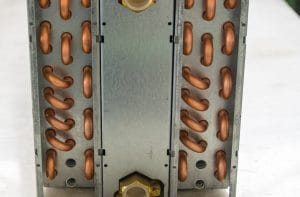 Heat pipes were among the first forms of heat exchangers to become popular, and they’ve remained the preferred solution for a wide range of applications. The popularity of modern heat pipes can be attributed to many different factors, from the eco-friendly way they transfer waste heat to the ease with which heat exchangers can be adapted for most applications’ thermal management needs. For many companies, the use of heat pipe heat exchangers for their electrical cooling needs creates a wide range of benefits.
Heat pipes were among the first forms of heat exchangers to become popular, and they’ve remained the preferred solution for a wide range of applications. The popularity of modern heat pipes can be attributed to many different factors, from the eco-friendly way they transfer waste heat to the ease with which heat exchangers can be adapted for most applications’ thermal management needs. For many companies, the use of heat pipe heat exchangers for their electrical cooling needs creates a wide range of benefits.
Transferring heat through heat pipes
Heat exchangers that utilize a heat pipe design transfer electrical waste heat using a cooling fluid that easily flows through the pipes. The cooling fluid that’s closest to an enclosure’s electrical components will absorb the waste heat these components constantly produce. Once the fluid reaches its latent heat of vaporization – the point at which it evaporates from a liquid into a gas – it becomes less dense. This makes it easier to travel through the heat pipes to a heat sink or other depository, where it can dissipate the heat and condense back into a liquid.
Customizing thermal management solutions
The greatest benefits of heat pipe heat exchangers stem from their ability to rapidly and efficiently transfer waste heat. For example, the process of transferring waste heat doesn’t take as much energy as processes that revolve around generating chilled air. This means companies can keep heat exchangers in operation longer while saving significant amounts of money on energy consumption. The simplified method of transferring waste heat is also highly customizable; heat pipes can be designed to bend in any direction and fit any plane while still providing optimal thermal management results.
When to choose heat pipes for electrical cooling
Custom heat pipe assemblies are commonly used in most industries, and for a wide variety of specific applications. For example, some electrical enclosure cooling systems utilize heat pipes to rapidly remove heat from multiple enclosures at once. More advanced applications might utilize heat pipes to not only absorb electrical waste heat, but also redirect and repurpose it for other processes that require heat. This helps companies streamline their overall operations as well as reduce or eliminate additional energy costs.
For more information about why heat pipes are among the most popular heat exchangers, call Noren Thermal Solutions in Taylor, TX, at 866-936-6736.







